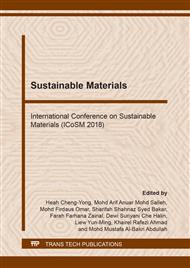p.206
p.215
p.221
p.226
p.231
p.237
p.243
p.251
p.258
Effect of Temperature on Oxide Growth Behaviour of Fe-33Ni-19Cr Alloy
Abstract:
The isothermal oxidation behaviour on two different temperature of Fe-33Ni-19Cr alloy was studied in this work. The present paper focuses on the isothermal oxidation behaviour at 700oC and 900oC. The oxidized samples were subjected to oxidation experiment under isothermal conditions for 500 hours. Scanning Electron Microscopy (SEM), Energy Dispersive X-Ray Spectroscopy (EDS) and X-Ray Diffraction (XRD) technique were employed in this study to analyse the oxidation behaviour of oxidized samples. The kinetics of oxidation followed the parabolic rate law which represent diffusion controlled oxide growth rate. Results indicate that Fe-33Ni-19Cr alloy oxidized at 700oC possess a better oxidation resistance with low Kp value of 2.39 x 10-7 mg2cm-4s-1. The oxide scale formed during oxidation were generally complex consists of several oxide phases. The samples morphologies of oxidized samples were influenced by the alloy structure and expose conditions. An elemental EDX line scan analysis of samples oxidized at 900oC indicated four different oxide layers composes of several oxide structure with evidence of internal oxide precipitates composed of Al-rich oxide phase.
Info:
Periodical:
Pages:
231-236
Citation:
Online since:
August 2018
Authors:
Keywords:
Price:
Сopyright:
© 2018 Trans Tech Publications Ltd. All Rights Reserved
Share:
Citation:


